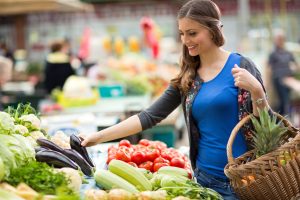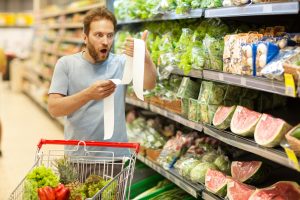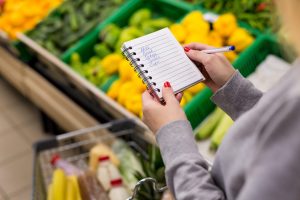The Smarts of Supermarket Shopping
Ita Yankovich

Ever unload your groceries after doing a weekly shop and wonder what on earth possessed you to purchase that family-sized bag of chips or that overpriced, gourmet chocolate bar? Well, like many others, you may have been duped into falling for those psychology funnels commonly referred to as the supermarket aisle.
The supermarket is not merely a place to buy common household items and groceries; it is a clever strategic setting that utilizes careful study of human mind and behavior to get you to spend more time and of course money on their inventory. So how do they do this and why do we continue to fall for their traps? Therein lies the question that nets an average store 60k – 80k in sales daily.
Sight, Smell and… Salad?
From the very first step into the grocery store, your every move and thought has been calculated and analyzed by marketing experts. Have you noticed that the entrance of most grocery stores is stocked with fresh fruits and vegetables? It has been proven that a colorful display of healthy foods entices us to spend without guilt.
“Retailers want you to be primed with the concept of freshness when you first walk in since it has a halo effect throughout your experience in the store. So, it’s no wonder that they place flowers, bakery, and produce when you first walk in,” explains Ben Applebaum, an executive creative director of the Feast agency, a company that focuses on brand experience innovation.
Store managers want to draw your attention to high-margin items that spoil quickly, like avocados or peaches, so they place them upfront. Popular staples with low margins and a long shelf-life, like garlic and potatoes get placed in the back and on the bottom. Produce is often displayed in neat rows, or perhaps in wooden baskets or crates reminiscent of the back of a farm truck. Fruits and vegetables are sprayed to give them just-plucked appearance. Some are polished, so they appear fresher. Lightbulbs with a slightly bluish tone make green vegetables seem lush and appetizing. Red-tinged bulbs are deployed in the meat department to make chops look straight off the butcher block, and yellow bulbs are used in the bakery to cast an extra golden glow on the loaves of bread.
Some supermarkets will entice you with the aroma of pastries when you first enter. To enhance your sense of smell, some stores use ventilation systems called electrostatic aroma diffusers to disperse appealing scents. One study found that gross sales increased by 14% in stores that released the scent of fresh melon into the shopping area. In some cases, the equipment masks unattractive smells, like seafood from the fish counter. They also pump the smell of fresh roses into the floral department or powder scent into the baby-products aisle.
Touch is very important when grocery shopping as there is a strong correlation between picking something up and then putting it in your cart. This is why so many stores have auto-stocking, so when an item is in your hand, you are less likely to deal with the hassle of putting it back.
“It’s also why the ‘Please Don’t Squeeze the Charmin’ campaign was so successful,” explains Ben Applebaum, who advises avoiding holding a product unless you are committed to buying it.
Yes, even the sense of sound is utilized to get you to open your wallet. Research indicates that music encourages customers to linger, and one study calculated that music with a slow tempo — below 72 beats per minute — led to a 38-percent increase in gross spending. Professor Laurence Minsky points to a famous UK study where a chain store broadcast German music one day and French music the next. During the days they broadcast German music, they sold more German wine, and during the days they played French music, they sold more French wine.
Location, Location, Location
Supermarket layout hasn’t changed much since the 50s, but we are still falling for all the same traps. Most stores have the milk, eggs, and meat in the back of the store because these are common staples, and it forces customers to have to go through the whole store to get to them. While doing this, a customer might decide that he will purchase another item that catches his eye.
Some companies pay “rent” to the supermarket to have their items displayed in a favorable spot. How the aisles are stocked is also no mystery. Brand names are always front and center, so you can just grab and go. If you want generic brands, you may have to stretch up to the highest shelf or crouch to the lowest. And if you’re in the cereal aisle, one of the most profitable ones in the whole store, then you will notice that sugary kid favorite selections are always going to be at their eye level and reach, says Professor Laurence Minsky, who teaches Communication and Media Innovation at Columbia College Chicago.
Prime real estate for any store is the cash register. This is the last opportunity to get you to spend on items you would usually not consider. Here is where you will find magazines, candy, toys, sanitizers, and batteries. How does this work? Every parent has been there: Your little one is throwing a temper tantrum while all eyes are on you. The quickest fix is to hand him a treat or a toy, no matter how overpriced.
The Center for Science in the Public Interest (CSPI), the oldest independent, science-based consumer advocacy organization, released a report confirming that the high-margin items sold by the register account for roughly 1-percent of a store’s sales but 25-percent of its overall profits — and that’s excluding placement fees. According to the same report, candy companies pay $3 to $5 per inch to get a new product on those register shelves — meaning it might cost more than $5 million to introduce one candy bar at the nation’s 50 largest grocery chains.
“Those six inches by the register, where impulse buying is high, can account for more than half of a candy maker’s profits in a store,” says Gary Rivlin, author of the CSPI report.
Some shoppers are clever and have the whole layout of the store mapped out in their heads, but managers will intentionally shift inventory around to keep you on your toes. Grocers are getting savvier about cross-marketing opportunities – which is why you’re more likely to see salsa near the tortilla chips or peanut butter near the crackers. These pairings might seem convenient for consumers, but typically the products on display carry high profit margins, or a manufacturer paid to have them placed there.
Digital Shopping
Online shopping has taken over retail shopping, with social media and other smartphone tools working together to get you to shop. Some stores will send you emails or alerts about upcoming offers on items that are frequently on your shopping list. They are not doing this to be nice, but rather to get you buy more of those items. They have tracked your spending history and know what and you purchase, using that data to lure you back.
Some big chains are implementing a digital marketing technique called geofencing, which uses location-based technology to detect your phone’s presence near their stores to send you alerts on special offers. For example, if a kid’s cereal company wants to target moms, it can “tag” users who check their phones in the morning near a school. Then when they are within one mile of the store, they can serve them up a banner for the product, explains Applebaum. Others are trying a related technique known as geoconquesting, in which they send deals to customers who are near a competitor’s market.
“Yes, you are being watched,” maintains Dr. Tim Lynch, CEO of Psychsoftpc, an American- based high performance computer manufacturer. “Those handheld self-checkout scanners can keep track of your location within the store and beep when you approach an item you have bought before by comparing the aisle to your rewards card.”
Once you have selected your items, supermarkets want you to purchase them quickly. Some major chain stores have a new system called QueVision, which senses how many people enter and exit the store using heat infrared sensors. This system is also placed near the checkout lanes, so managers know when to open more registers to reduce customer wait time.
Food prices are increasing, there is no stopping or denying that, but caveat emptor: let the buyer beware. Learn how to be a savvy shopper and avoid the pitfalls. Stores are not the enemy. They are trying to make food shopping a weekly necessity and a convenient experience for you that’s lucrative for them. It’s our job to be mindful and educated and decide exactly how much we would like them to profit.

Receipt Rip-off
If you feel like your receipt seems inflated at the end of every shopping excursion, yet your wagon looks depleted, it is not an optical illusion. Food prices have surged to the highest level in more than a decade and it’s making consumers lose their appetites. According to the USDA’s Economic Research Service, an agency which predicts inflationary pressure of food prices, 2021 food prices have increased by 2.5 to 3.5 percent. 2022 will look no better with the agency cautioning the public that this trend will continue to increase.
We reached out to local kosher supermarkets including Shop Smart, Mountain Fruit, Kosher Palace, and Glatt Mart for industry input on why this is happening, and they all pointed fingers at the same source: COVID-19. Food producers have struggled with shortages, bottlenecks, transportation issues, and labor shortages: all effects of the pandemic.
Mehadrin’s recent statement announced: “Due to the influence of many factors, including the continuing increase in prices of various raw materials along with rising transportation charges during this past year, we find it necessary to implement this price increase.”
Mindy Shtesl from the accounting department of Mountain Fruit echoed the same sentiment. “With the halt in production due to the pandemic, there are fewer goods to get and if there are, the price will automatically go up. It’s simple supply and demand,” she explains.
“I think it’s all political,” says Michael Jaffa, manager of Kosher Palace. He believes that China and certain politicians are taking advantage of the pandemic. Michael, who has been in the business for 30 years, says that he has never seen prices skyrocket as they have for the past six months. “I’m devoting three to four hours a day just dealing with price increases,” he adds.
The public worries when they see unstocked shelves, but Gershon Menzer, owner of Supermarket of Avenue N, assures readers that supply is not the problem; manpower is the problem. “The products are all there; they are ready for pick up, but there are not enough truckers and people who are willing to work to transport the items to the stores,” he explains. Gershon cites attractive unemployment benefits as the root of this trickle-down dilemma.
It’s not only small stores. Gershon relates that even huge companies like Coca Cola have tons of excess product, but no drivers to distribute them. Kosher Palace reports not being able to secure a Coca Cola delivery for three weeks. “Unemployment is killing business and driving up the prices,” Gershom says.
Ari Nussencweig, owner of Mountain Fruit, sympathizes with the kosher consumer and recommends trying to buy most of your goods online to avoid impulse buying and making two trips a week to the store. “The more you go to the store, the more you end up spending. Two bigger orders versus. five smaller orders will save you money and you will end up eating what you have in your house already,” he says.
Mindy advises checking out in-store specials that are not publicly advertised. “We can’t advertise everything, and there’s usually big savings there,” she says.
Michael recommends stocking up on paper goods and essentials now, while prices are somewhat stable.
“Until recently, many families received free food boxes so they didn’t feel the crunch like they do now,” says Aryeh Klein, manager of Shop Smart. “It’s basically a supply chain issue, so that is why you are spending 30-percent more than last year.” Aryeh says Shop Smart is forced to make many price changes a week due to this issue.
For example, according to Ari, watermelon normally sells at this time of year for 99 cents a pound, but because it ships from Texas and truckers are a scarcity, the prices have skyrocketed to $1.99 a pound. Disposable aluminum pans, another hot item for large families, used to cost 17 cents apiece, according to Michael, but now they have ballooned to 39 cents. Managers from all the kosher establishments we interviewed reported that despite the current situation, they work tirelessly to keep prices at bay by lowering their margins wherever they can.
“The ports in California cannot be congested forever and eventually, this issue will be resolved,” Michael says. “In the meantime, don’t panic and understand that Hashem controls it all.”

Outsmarting the Supermarket
Bring a list and stick to it to avoid impulse purchases.
Avoid going food shopping when you’re hungry or tired.
Use cash instead of credit cards or check, so you know your spending is limited.
Always review the receipts for mistakes before exiting the store.
Shopping cart sizes have doubled over the past few years, so opt for a basket instead.
If you insist on buying in bulk in stores like BJ’s and Costco, shop with a friend or relative since many of the best offers may not be worthwhile for a single family. However, splitting items can help you take advantage of the bargains without buying more than you need.

You must be logged in to post a comment.